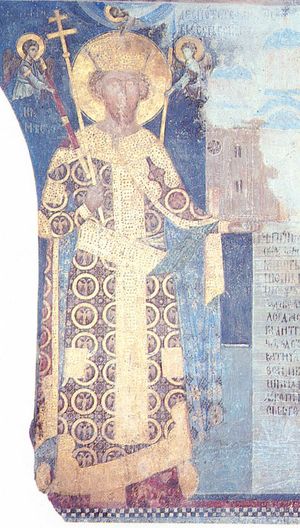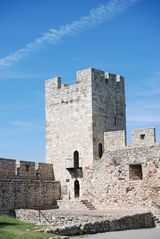ستفان لازارڤتش
| ستفان لازارڤتش Stefan Lazarević | |
|---|---|
| مستبد صربيا | |
 | |
| العهد | كنـِز (1389–1402) مستبد (1402–1427) |
| سبقه | لازار من صربيا |
| تبعه | Đurađ Branković |
| وُلِد | c. 1377 كروشڤاتس، صربيا الموراڤية |
| توفي | 1427 گلاڤا، الاستبدادية الصربية |
| المدفن | |
| البيت | لازارڤتش |
| الأب | لازار من صربيا |
| الأم | Princess Milica of Serbia |
ستفان لازارڤتش (Stefan Lazarević ؛ سيريلية صربية: Стефан Лазаревић؛ ح. 1377 – 19 يوليو 1427)، ويُعرف أيضاً بإسم ستفان الطويل (بالصربية: Стефан Високи / Stefan Visoki)، كان حاكم صربيا كأمير (1389-1402) و كمستبد (1402-1427). وهو ابن الأمير Lazar Hrebeljanović, he was regarded as one of the finest knights and military leaders in Europe. After the death of his father at Kosovo (1389)، أصبح حاكم صربيا الموراڤية and ruled with his mother Milica (a Nemanjić), until he reached adulthood in 1393. Stefan led troops in several battles as an Ottoman vassal, until asserting independence after receiving the title of despot from the Byzantines in 1402.
Becoming an Hungarian ally in 1403–04, he received large possessions, including the important Belgrade and Golubac Fortress. He also held the superior rank in the chivalric Order of the Dragon. During his reign there was a long conflict with his nephew Đurađ Branković, which ended in 1412. Stefan also inherited Zeta, and waged the war against Venice. Since he was childless, he designated his nephew Đurađ as heir in 1426, a year before his death.
On the domestic front, he broke the resistance of the Serbian nobles, and used the periods of peace to strengthen Serbia politically, economically, culturally and militarily. In 1412 he issued the Code of Mines, with a separate section on governing of Novo Brdo – the largest mine in the Balkans at that time. This code increased the development of mining in Serbia, which has been the main economic backbone of Serbian Despotate. At the time of his death, Serbia was one of the largest silver producers in Europe. In the field of architecture, he continued development of the Morava school. His reign and personal literary works are sometimes associated with early signs of the Renaissance in the Serbian lands. He introduced knightly tournaments, modern battle tactics, and firearms to Serbia. He was a great patron of the arts and culture by providing shelter and support to scholars, and refugees from neighboring countries that have been taken by the Ottomans. In addition, he was himself a writer, and his most important work is A Homage to Love, which is characterized by the Renaissance lines. During his reign the Resava School was formed.
الخلفية والعائلة
Stefan was the son of the prince of Moravian Serbia, Lazar and his wife Milica, a lateral line of Nemanjić. Hrebeljanović's father Prince Vratko was a direct descendant of Vukan, eldest son of Stefan Nemanja. In addition to Stefan, they had seven other children.[1][2][3]
الزواج
| أشقاء وشقيقات ستفان | |||
|---|---|---|---|
| Stefan's brothers | |||
| الاسم | الحياة | اللقب | |
| Dobrovoj | (Died as a child) | ||
| Vuk | (?—1410) | prince | |
| Stefan's sisters | |||
| Name | Lifespan | Marriages | |
| Мara | (?—1426) | Vuk Branković, c. 1371[1][2][4] | |
| Jelena | (?—1443) | 1.Đurađ II Stracimirović Balšić (1385 — 1403), c. 1386[1][2] 2.Sandalj Hranić (1392 — 1435), 1411 | |
| Dragana[3][4] | (?—?) | Ivan (1371 — 1395) or his son Alexander, c. 1386[4] | |
| Teodora (Jelena) | (?—before 1405)[3] | Nikola II Gorjanski, c. 1387[1][2] | |
| Olivera | (c. 1378[1] — after 1443[2][3]/1444[1]) | Bayezid I (1389—1403), 1390 | |
حاكم صربيا
السنوات المبكرة
Stefan was the son of Prince Lazar, whom he succeeded in 1389. Nikola Zojić attempted to overthrow Stefan Lazarević at the end of 14th century and used Ostrvica as haven after his attempt failed.[5]
Lazarević participated as an Ottoman vassal in the معركة روڤينه in 1395, the Battle of Nicopolis in 1396, and in the Battle of Ankara in 1402.[6]
بعد معركة أنقرة
The Ottoman defeat at Ankara (July 1402) and disappearance of Sultan Bayezid I provided opportunity for the Serbian magnates to take advantage of the turmoil and pursue independent politics.[7] They returned home from the battlefield via Byzantine territory; in August 1402 at Constantinople, as the new conditions made for closer Byzantine–Serbian cooperation, Stefan Lazarević and his men were not only well-received, but Emperor John VII Palaiologos decided to award him the very high title of Despot.[7]
معرض صور
- Stefan Lazarevic Despotate 1422.svg
Stefan Lazarević Despotate in 1422
Lazarević dynasty coat of arms
Stefan Lazarević tomb in Manasija monastery
Despot Stefan Lazarević Memorial in the courtyard of a church in Crkvine, Mladenovac
انظر أيضاً
الهامش
- ^ أ ب ت ث ج ح Ivić, Aleksa (1928). Родословне таблице српских династија и властеле. Novi sad: Matica Srpska. p. 5.
- ^ أ ب ت ث ج "Genealogy - Balkan states: The Lazarevici". Retrieved 25 February 2010.
- ^ أ ب ت ث "Medieval Lands project - Serbia: ''Lazar I [1385]-1389, Stefan 1389-1427''". Retrieved 25 February 2010.
- ^ أ ب ت Андрија Веселиновић Радош Љушић, "Српске династије" , Нови Сад, 2001. ISBN 86-83639-01-0
- ^ Đurđe Bošković (1956). Arheološki spomenici i nalazišta u Srbiji: Centralna Srbija. Naučna knjiga. p. 54. Retrieved 5 July 2013.
- ^ The Balkans, 1018-1499, M. Dinic, The Cambridge Medieval History, Vol. 4, Ed. J. M. Hussey, (Cambridge University Press, 1966), pg. 551.
- ^ أ ب Kalić 1982a, p. 65.
المصادر
- Bogdanović, Dimitrije; Mihaljčić, Rade; Ćirković, Sima; Kalić, Jovanka; Kovačević-Kojić, Desanka; Blagojević, Miloš; Babić-Đorđević, Gordana; Đurić, Vojislav J.; Spremić, Momčilo; Božić, Ivan; Pantić, Miroslav; Ivić, Pavle (1982). Kalić, Jovanka (ed.). Историја српског народа: Доба борби за очување и обнову државе (1371–1537). Belgrade: Srpska književna zadruga.
- Kalić, Jovanka (1982a). "Велики преокрет". Историја српског народа: Доба борби за очување и обнову државе (1371–1537). pp. 64–74.
{{cite book}}: Invalid|ref=harv(help) - Kalić, Jovanka (1982b). "Немирно доба". Историја српског народа: Доба борби за очување и обнову државе (1371–1537). pp. 75–87.
{{cite book}}: Invalid|ref=harv(help) - Blagojević, Miloš (1982). "Врховна власт и државна управа". Историја српског народа: Доба борби за очување и обнову државе (1371–1537). pp. 109–127.
{{cite book}}: Invalid|ref=harv(help)
- Kalić, Jovanka (1982a). "Велики преокрет". Историја српског народа: Доба борби за очување и обнову државе (1371–1537). pp. 64–74.
- Purković, Miodrag (1978). Knez i despot Stefan Lazarević. Sveti arhijerejski sinod Srpske pravoslavne crkve.
{{cite book}}: Invalid|ref=harv(help) - Stojaković, Slobodanka (2006). Деспот Стефан Лазаревић. Српско нумизматичко друштво. ISBN 978-86-902071-6-9.
- Trifunović, Đorđe, ed. (1979). "Stefan Lazarević". Књижевни радови. Srpska književna zadruga. 477.
- Veselinović, Andrija (2006) [1995]. Држава српских деспота [State of the Serbian Despots]. Belgrade: Zavod za udžbenike i nastavna sredstva. ISBN 86-17-12911-5.
للاستزادة
- Books
- Life of Despot Stefan Lazarević by Constantine the Philosopher (ca. 1431).
- Braun, Maximilian, ed. (1956). Lebensbeschreibung des Despoten Stefan Lazarević. Mouton.
- Mirković, L., ed. (1936). Живот деспота Стефана Лазаревића. СКЗ.
{{cite book}}:|work=ignored (help) - Jagić, V., ed. (1875). "Константин Филозоф, „Живот Стефана Лазаревића"". Гласник Српског ученог друштва. 42: 223–328.
- Journals
- Antonović, Miloš (1992). "Despot Stefan Lazarević i Zmajev red".
{{cite journal}}: Cite journal requires|journal=(help) - Glušac, Jеlena (2015). "Prince and despot Stefan Lazarević and monastery of Great Lavra of Saint Athanasius on Mount Athos". Zbornik Matice srpske za drustvene nauke. 153: 739–746.
- Kalić, Jovanka (2006). "Despot Stefan and Byzantium". Zbornik radova Vizantološkog instituta. 43: 31–40.
- Kalić, Jovanka (2005). "Despot Stefan i Nikola II Gorjanski".
{{cite journal}}: Cite journal requires|journal=(help) - Kotseva, Elena (2014). "The Virtues of the Ruler according to the Life of Stefan Lazarević by Constantine of Kostenets". Scripta & e-Scripta. 13: 123–129.
- Krstić, Aleksandar (2015). "Два необјављена латинска писма деспота Стефана Лазаревића" [Two unpublished Latin letters of Despot Stefan Lazarević]. Иницијал. 3: 197–209.
- Mihailović-Milošević, S. (2012). "Literary character of the Despot Stefan Lazarević in The Lives of Constantine Philosopher" (PDF). Baština (32): 41–49.
- Pantelić, Svetlana (2011). "Money of despot Stefan Lazarević (1402-1427)". Bankarstvo. 40 (9–10): 122–127.
- Popović, Mihailo (2010). The Order of the Dragon and the Serbian despot Stefan Lazarević. Austrian Academy of Sciences Press. ISBN 978-3-7001-6685-6.
{{cite book}}:|work=ignored (help) - Petrović, Nebojša (2012). "Viteštvo i Despot Stefan Lazarević" (PDF). Viteška kultura. 1 (1): 23–36.
- Spremić, Momčilo (2008). "Деспот Стефан Лазаревић и "господин" Ђурађ Бранковић" [Despot Stefan Lazarević and "Sir" Đurađ Branković]. Историјски часопис. 56: 49–68.
- Šuica, Marko (2009). "Битка код Никопоља у делу Константина Филозофа" [The Battle of Nicopolis in the work of Constantine the Philosopher]. Историјски часопис. 58: 109–124.
- Šuica, Marko (2013). "O години одласка Кнеза Стефана Лазаревића у Севастију". Zbornik radova Vizantološkog instituta. 50 (2): 803–810.
- Šuica, Marko. "Властела кнеза Стефана Лазаревића (1389-1402)". ГДИ. 1: 7–31.
- Türkmen, İlhan (2013). "Osmanlı'nın Emrinde Bir Sırp Despotu: Stefan Lazareviç" [A Serbian Despot Under The Heel Of The Ottoman Empire: Stefan Lazarevic] (PDF). Uluslararası Sosyal Araştırmalar Dergisi. 6 (28).
- Symposia
- Ресавска школа и деспот Стефан Лазаревић: округли сто, Манастир Манасија 28.08. 1993. Народна библиотека Ресавска школа. 1994. ISBN 978-86-82379-03-4.
وصلات خارجية
ستفان لازارڤتش وُلِد: circa 1372/77 توفي: 19 July 1427
| ||
| ألقاب ملكية | ||
|---|---|---|
| سبقه Lazar of Serbia |
Serbian Prince 1389–1402 |
شاغر اللقب حمله بعد ذلك Đurađ Branković
|
| New creation | Serbian Despot 1402–1427 | |
- Articles containing صربية-language text
- CS1 uses الصربية-language script (sr)
- CS1 errors: periodical ignored
- Pages using authority control with unknown parameters
- مواليد عقد 1370
- وفيات 1427
- 14th-century Serbian monarchs
- 15th-century Serbian monarchs
- مستبدو صربيا
- أسرة لازارڤتش
- Christians of the Crusade of Nicopolis
- Order of the Dragon
- أشخاص من كروشڤاتس
- Medieval Serbian writers
- شعراء صرب
- Serbian saints of the Eastern Orthodox Church
- 14th-century Serbian writers
- 15th-century Serbian writers
- Christian writers
- ملوك أرثوذكس
- Burials at Serbian Orthodox monasteries and churches
- Eastern Orthodox royal saints
- فرسان مجريون
- 15th-century Hungarian nobility




